by bria4123 on January 1, 2012
Baksei Chamkrong is another easily overlooked Khmer temple that’s well worth savoring. Harhavarman, the king when Prasat Kravan was built, probably started its construction. The great king Rajendravarman, the builder of Pre Rup, finished it. Harshavarman started it in the shadow of his father’s great temple Phnom Bakheng. The latter crowns a 200 foot high hill. Baksei Chamkrong is 42 feet high and 88 feet wide. It’s a much humbler effort, but like Prasat Kravan, it set new standards for blending elegance and simplicity.
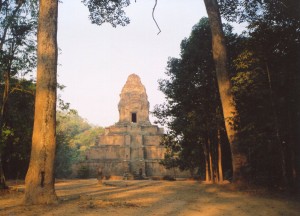
It’s only about half a mile from Angkor Wat. You’ll find Baksei Chamkrong refreshing after Angkor Wat’s overwhelming scale. [click to continue…]
by bria4123 on January 1, 2012
Papa was a rocker. The Khmer king Yasovarman had built some of the most stunning monuments Cambodians had seen so far, founded the city of Angkor, and cemented thought patterns that lasted throughout Khmer history. His two sons who then became kings inherited a great legacy, but they were saddled with a tough act to follow.
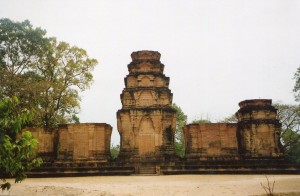
Little is known about both, but neither seems to have had the resources to compete with Yasovarman’s grandeur–or maybe they were more comfortable to bask in their father’s achievements and enjoy a luxurious life without working as hard as he did. Either way, both presided over the building of unique monuments that are almost as rewarding to explore as Yasovarman’s. They’re in the middle of Angkor, and thus easy to get to once you’re there. [click to continue…]
by bria4123 on December 31, 2011
In this final post on the Minoans, we’ll see how they ended, but they never really did end.
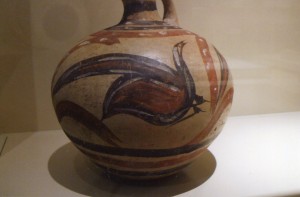
At the dawn of Western history, the Minoans created many cultural standards that have yet to be surpassed. [click to continue…]
by bria4123 on December 29, 2011
In this part on the Minoans, we’ll explore some details of the Palace at Knossos, and see some of their daily life.
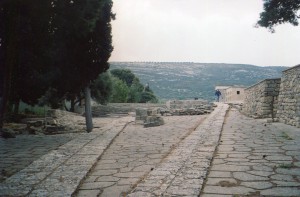
1. A theater spreads on the western side of the palace. The above photograph shows the paved yard and the seats behind it. It might have been used for religious rituals. The small number of seats indicates that the audience was aristocratic. Maybe people from other palaces came here and pledged loyalty to Knossos, which had grown into the largest royal residence. The paved yard suggests that the famous bull jumping rituals didn’t happen here, or in the palace’s courtyard, which was also paved. The stones would have made a bone-crunching surface to land on. Minoans made many paintings of processions, so maybe they used this place for some of them. The yard is both elegant and intimate. It’s also stately, yet in harmony with the natural surroundings. Minoan art has all these features. The more you hang around this palace, the more beautiful you find it to be. [click to continue…]
by bria4123 on December 27, 2011
The Palace at Knossos can pull you into a different world that you may find more appealing than your own. At least that’s how its excavator Arthur Evans reacted to it, and he pulled $1million from his own wallet to make it more vivid.
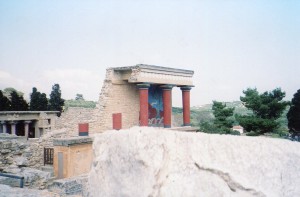
Controversies have flared over the authenticity of Evans’ restorations–columns and the painting in the above picture are his creations. Restorations of the old Thai city of Sukhothai by King Mongkut in the nineteenth century have also been questioned. Both men wanted to project ideals of the beginnings of their civilizations. But though the main characteristics of both have been questioned lately, these two idealized sites have usually presided over people’s identities, and given them models for their basic values. So what’s so good about Knossos? Let’s see. [click to continue…]
by bria4123 on December 27, 2011
Arthur Evans was so entranced by the Minoan palace at Knossos, Crete, that he spent 35 years excavating and reconstructing it between 1900 and 1935. He financed much of the work himself.
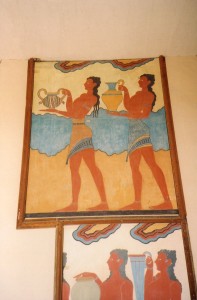
Alas, I didn’t have as much time or money as he did, but I spent 4 hours ambling through the site, and felt deeply immersed in it, as though it holds timeless truths about living well. Why is it so appealing? [click to continue…]
by bria4123 on December 25, 2011
The Khmer king Yasovarman I was ready to rock. He had honored his father, King Indravarman I, with the Lolei temple. Now he aimed to create a stellar future nobody in Khmer society had reached for.
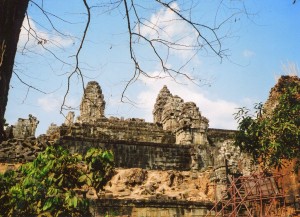
Yasovarman began by founding the city of Angkor. He did it in dramatic fashion. [click to continue…]
by bria4123 on December 24, 2011
The Khmer king Yasovarman I was both a conservative and a radical. What congressperson in Washington DC has a big enough imagination to be both?
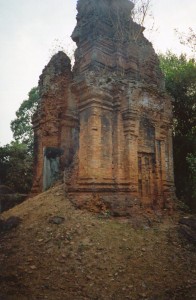
Yasovarman succeeded his father, Indravarman I. We saw Indravarman’s illustrious work in The Bakong, The First Khmer Skyscraper, and in
Preah Ko, A Jewel of Khmer Architecture. Yasovarman would outdo him by moving the capital and founding the city that later kings built Angkor Wat and other huge temples in. But before creating something greater than Khmers had ever seen, he paid homage to his father by building a beautiful temple that’s now called Lolei. This dream son respected his family line’s past, then took it to new heights. [click to continue…]
by bria4123 on December 24, 2011
Preah Ko was one of the most influential works of art in Khmer history. We had an introduction to it in Preah Ko, A Jewel of Khmer Architecture, Part One.
We’ll now find out what makes it special.
King Indravarman built it in the Khmer capital at Rolous as a temple to his ancestors. It thus has an intimate atmosphere that contrasts with later eye-bulging monuments like Angkor Wat. Preah Ko was the first major temple in Angkor’s area, but it set a standard of elegance for the next 600 years.
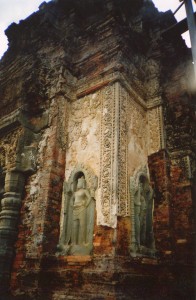
Come into its heart. [click to continue…]
by bria4123 on December 23, 2011
If Indravarman had only built the Bakong, he would have made artistic history. But that great temple was only one in a trinity of monuments that he and many later Khmer kings erected. The Bakong was in the form of the mountain at the center of the universe, and his royal cult was centered there.
The second monument was much larger–the first of the great Barays. Barays were human-made reservoirs up to 4 miles long that were used for both irrigation and religious symbolism. They bolstered the king as the bringer of rains and life–an Eastern Pharaoh with an elephant army.
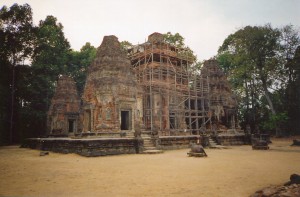
But if you explore the third monument, Preah Ko, you might find it the most pleasing. We’ll venture into it right now. [click to continue…]










